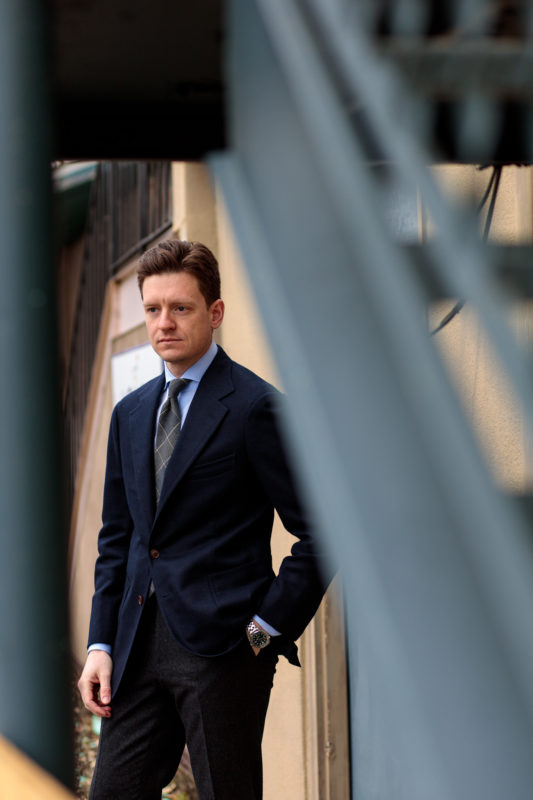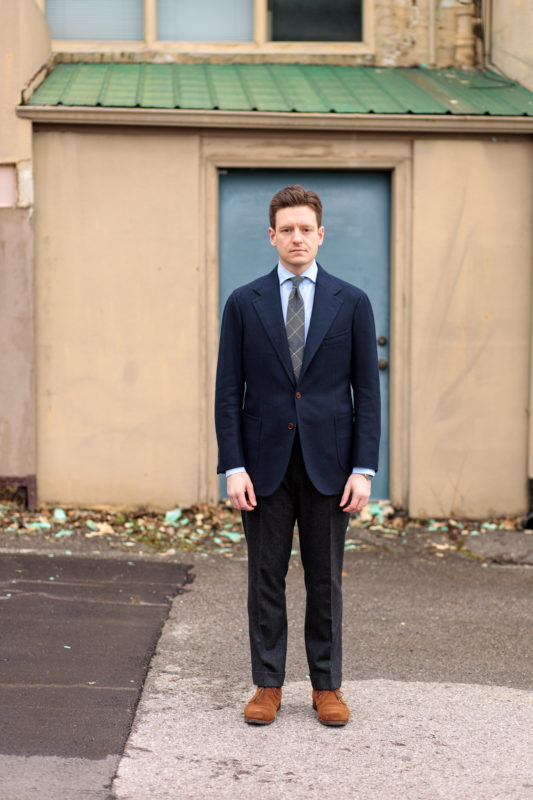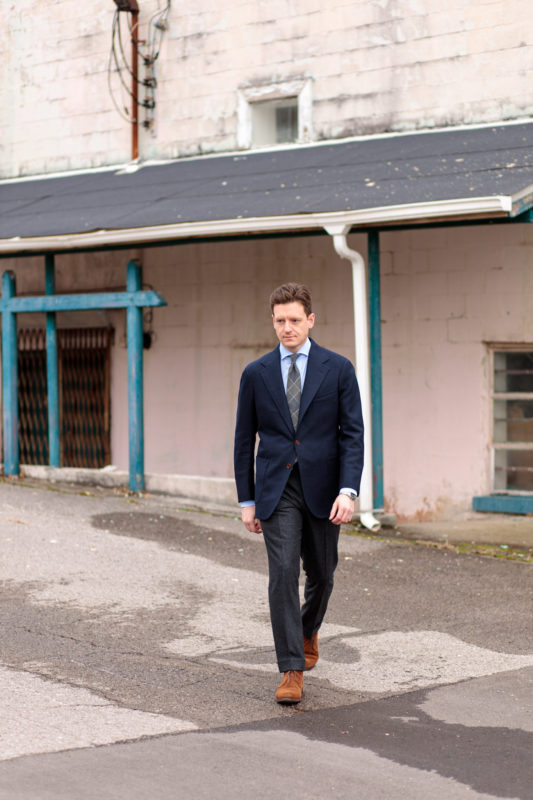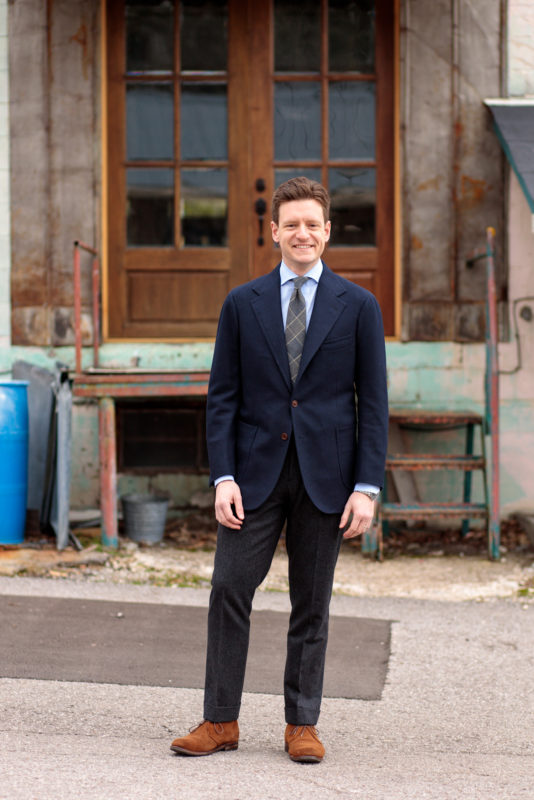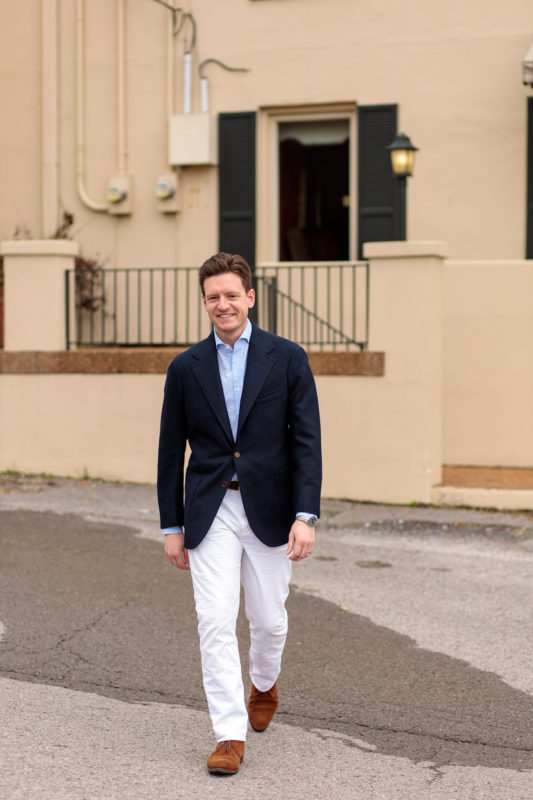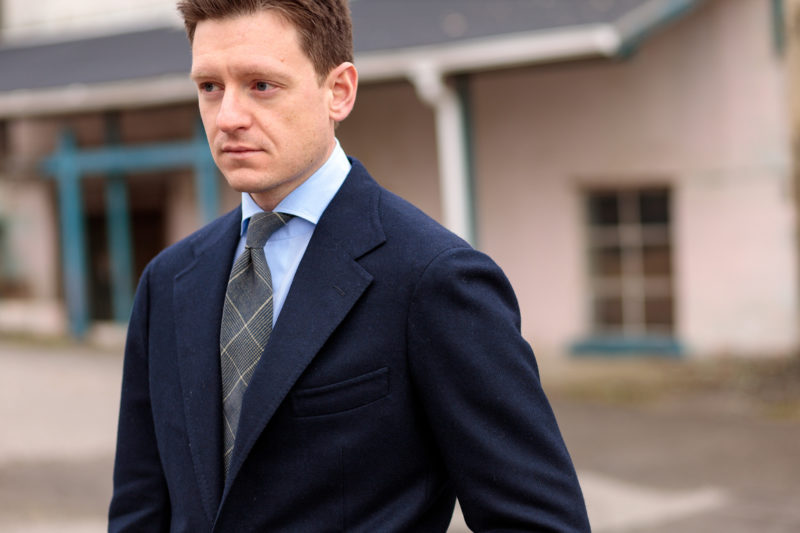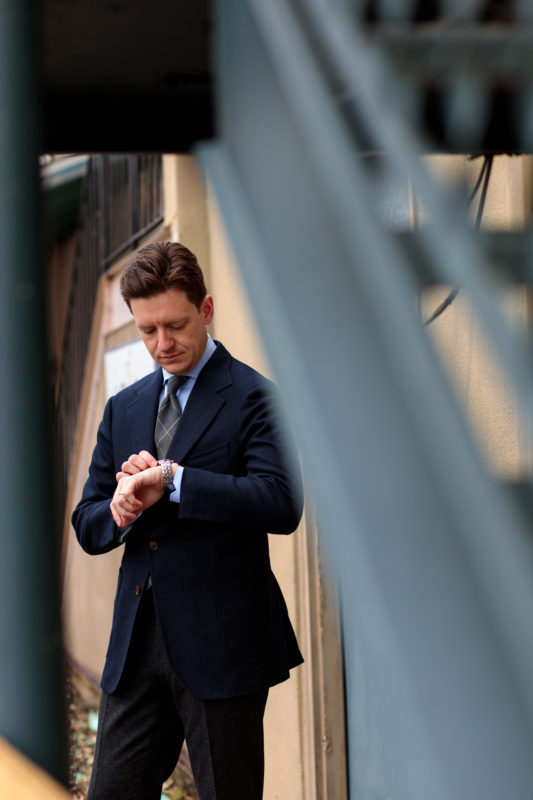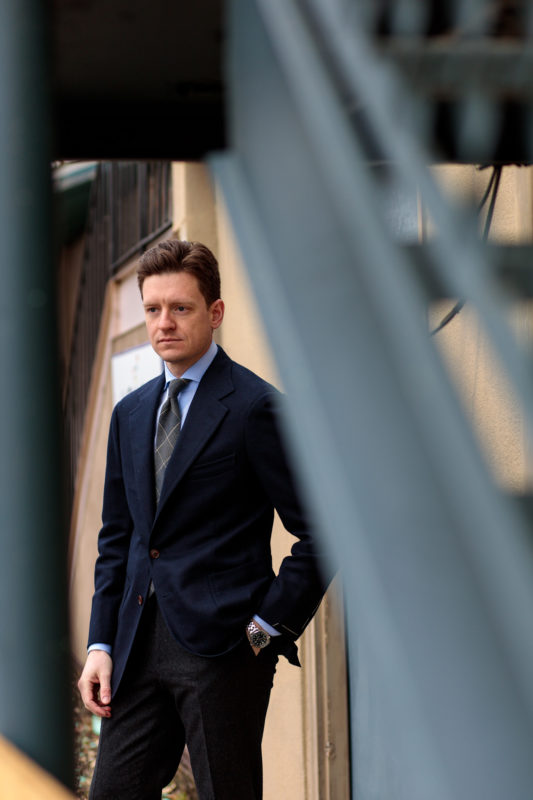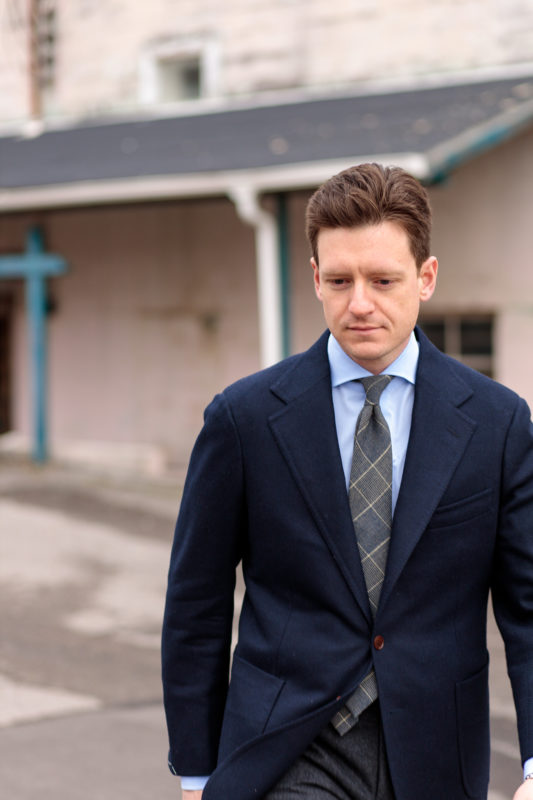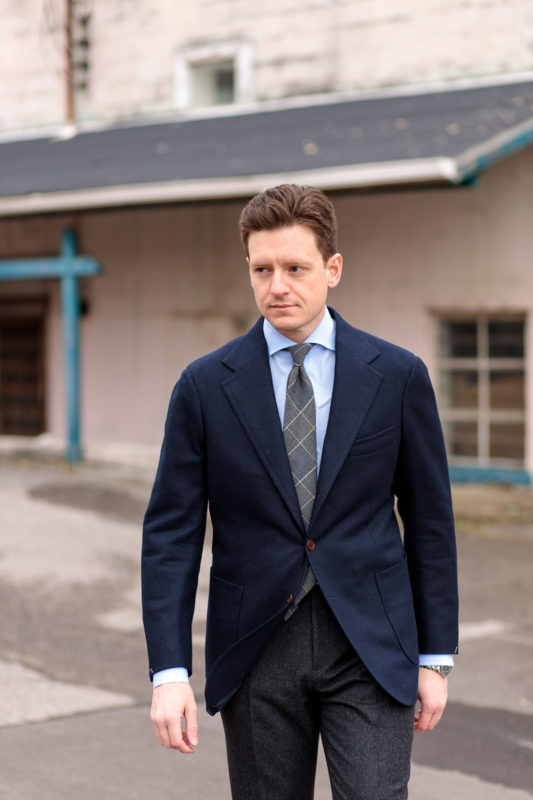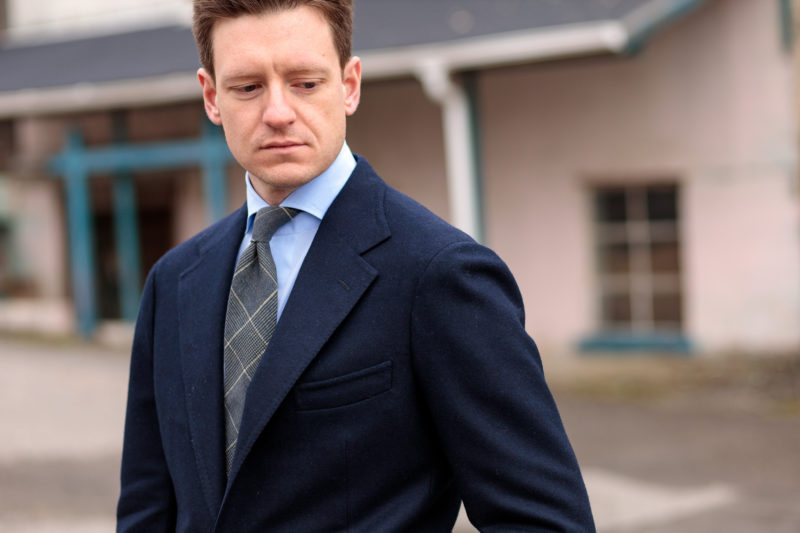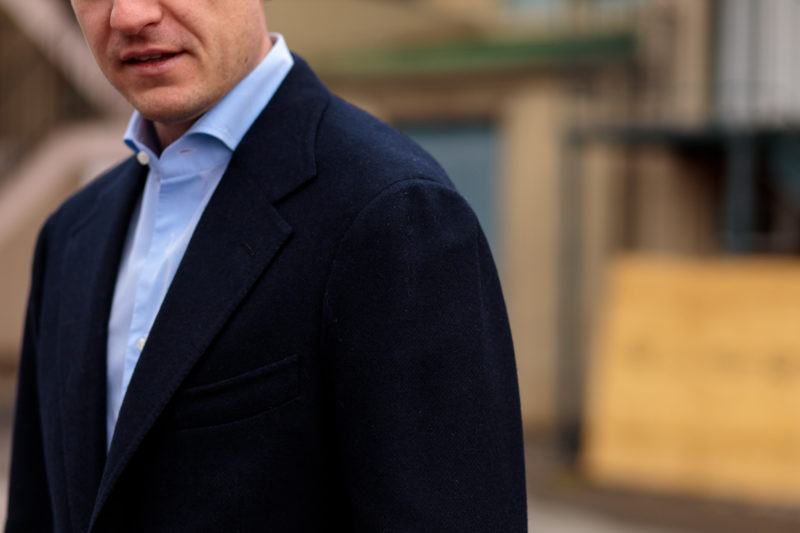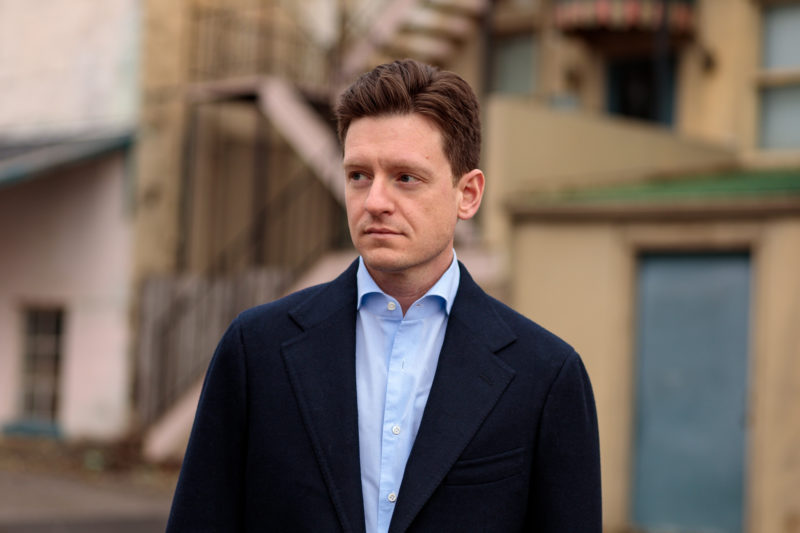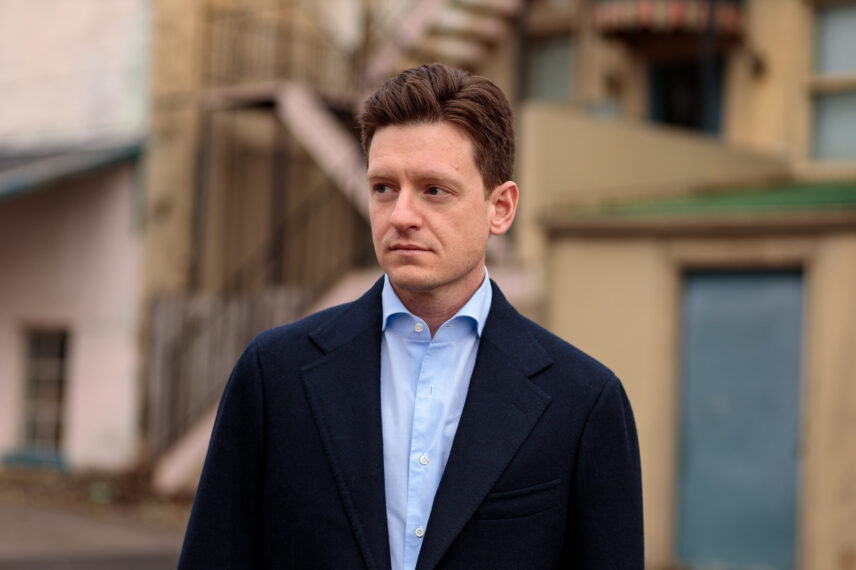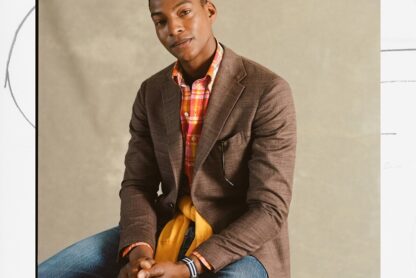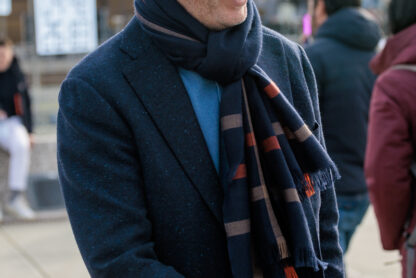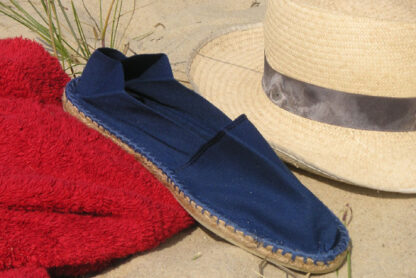Of course, it’s the tailoring-centric world of dressing I enjoy most, and they’ve had that on lock since day one. Beginning with a custom line of hand-made suits and jackets from bespoke maker Sartoria Formosa, NMWA added Eidos to their line-up within the first year—at first carrying the beautiful but somewhat flawed Lorenzo cut for one season before customizing it with Antonio Ciongoli to develop the exclusive NMWA cut. Season after season, Greg consistently carried the coolest looking Eidos product of any retailers who carried the brand (for instance, to my knowledge nobody else sold the emerald green herringbone sportcoat Greg carried, which is one of my all time favorite fabrics).
Once Antonio left, and the two-season extension of the NMWA cut that Eidos/Isaia gave to NMWA came to a close, there was a gap in the lineup for tailoring at that price point. Enter the No Man Walks Alone house label, made by Sartoria Carrara. A product of multiple years of research and development to find the right partner in Italy, this line of tailoring is something special. Greg gives some context and background of their Italian manufacturer at the bottom, but let’s jump into my impressions of the garment first.
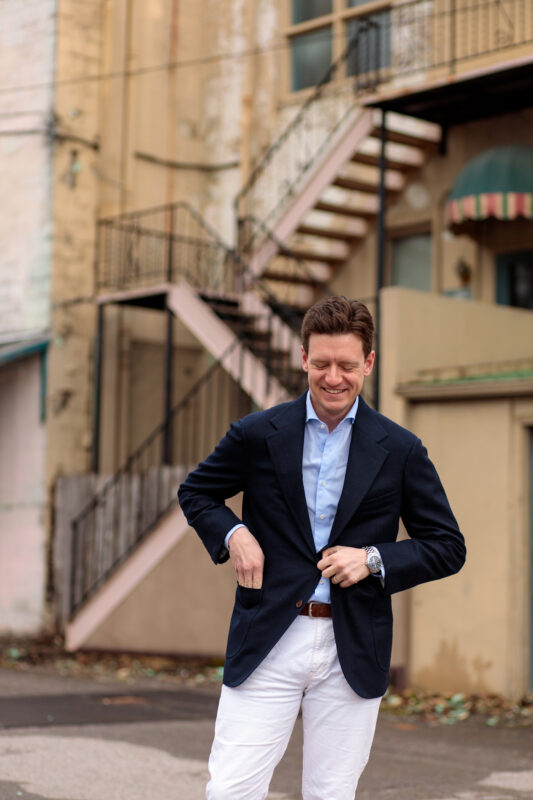
The Real Deal
Putting it on for the first time and looking at it in the mirror gave me one overarching feeling: This is a grown man’s jacket. In recent months, as I’ve personally grown and changed as a result of becoming a dad, I’ve been going through a recalibration of my tastes in various ways. This jacket embodies some of those updated preferences as pertaining to a tailored jacket. It fits a bit looser in a few respects than my beloved Eidos jackets—a lower armhole, a looser sleeve, and a more voluminous upper chest and back (plus a looser waist off the rack). Those first three things in particular create a feeling of easiness from the first moment you slip it on—it’s not only easier to put on but it’s literally less restricting in the shoulder blades and elbows as you move around.
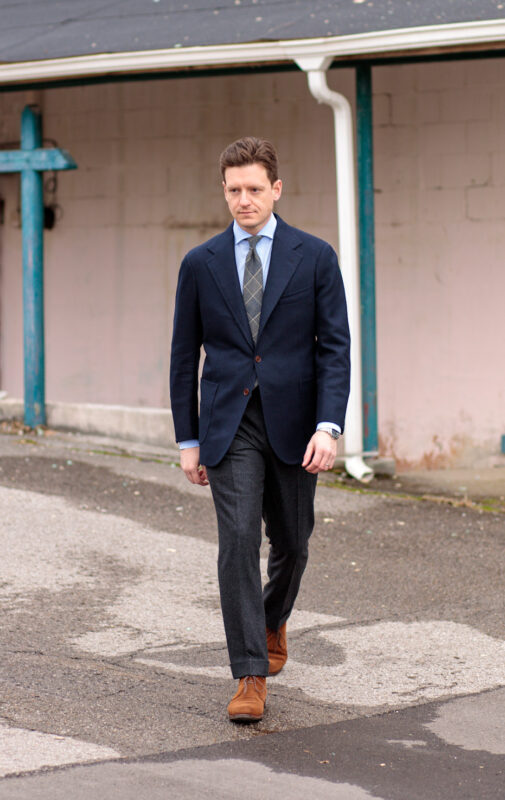
The shoulder is clean and natural; there is no padding at all, just the layers of canvas in the chest extending up over the shoulder to make that line straight and clean; the shoulder expression where the sleeve attaches to the shoulder is pure shirt sleeve style (spalla camicia), with no decorative pleating (grinze). It strikes an excellent balance between a natural, unpadded look and the overly round, “bald” sleeve head that many completely unstructured jackets have. I like a natural shoulder, but one that still creates a bit of an angle at the end. No grinze means this probably won’t get strange looks in the office. I’ve never been one to idolize those pleats anyway.
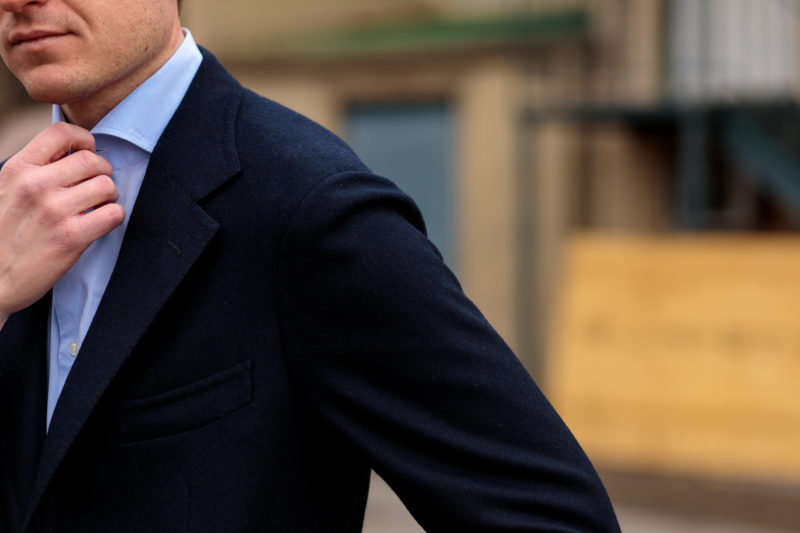
It’s also an extended shoulder style; the end of the shoulder where the sleeves attach falls maybe a half or three quarters inch past my actual shoulder bone. As Derek Guy wrote recently, the extended shoulder is a flattering look, helping to create a more athletic V-shaped silhouette.
The overall structure of it is an ideal middle ground, in my opinion—just enough canvassing throughout the body to give it shape and to clean that shoulder line, but not so heavy so as to be stiff.
Though on paper it’s no longer than any of my other sport coats, it looks like it is. The reason is twofold. First, the quarters aren’t as rounded as those other coats. Second, the buttoning point perfectly bisects the front, giving both a long lapel line above the button as well as a long line through the hem below the button. The long lapel line accentuates that visually appealing V shape above, and it creates symmetry with the quarters being slightly open below.
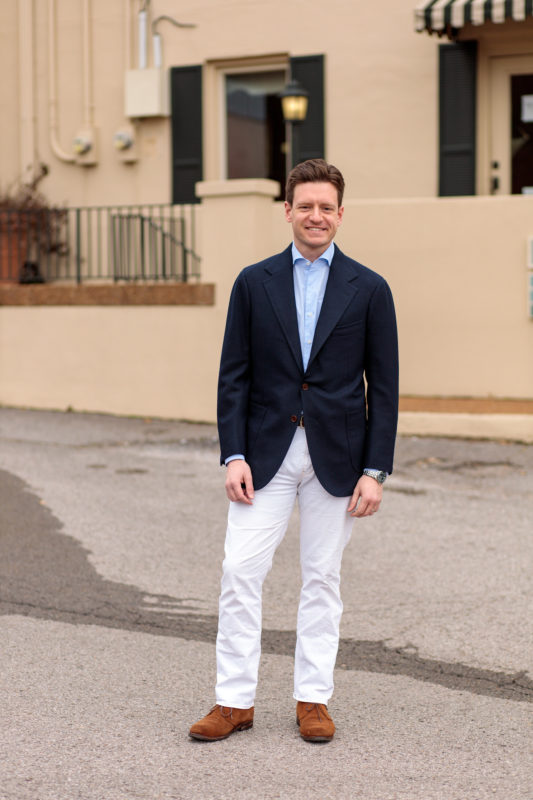
The gorge height is slightly lower, and is something I really wondered if I’d like. My tastes have tended toward a high gorge, with a notch angled toward the sky. Many of my jackets have this and I still like the look. I grew up seeing low-gorge jackets from the 1980s and 90s, and absolutely hated it. Like with pleats, my taste is defined as much by what I strongly dislike from my childhood as it is what I love. But a slightly lower gorge, and more outward-angled notch has its advantages; it can visually make your shoulders seem wider, primarily. And just as with lapel width, a gorge height that’s neither super high nor super low, but somewhere in the middle, will age more gracefully and feel more classic than either of those extremes.
The gorge, combined with the confidently wide lapels contributes to that mature look I mentioned. That feeling of maturity stems not just from my personal associations of how a grown, respectable man might dress, but also from how this jacket embodies a genuine Tuscan style developed by artisans with decades of experience. “We stepped back and wanted to revert to proportions that make sense for the wearer, that are comfortable and flattering. The best way to do that was to reset the style to what Sartoria Carrara’s house cut was as a Tuscan tailor, removing the layers of design changes that their other clients had added. From that point on, we made very few changes (we lowered the buttoning point a little and lengthened the coat a little) to stay true to their core DNA,” Greg told me.
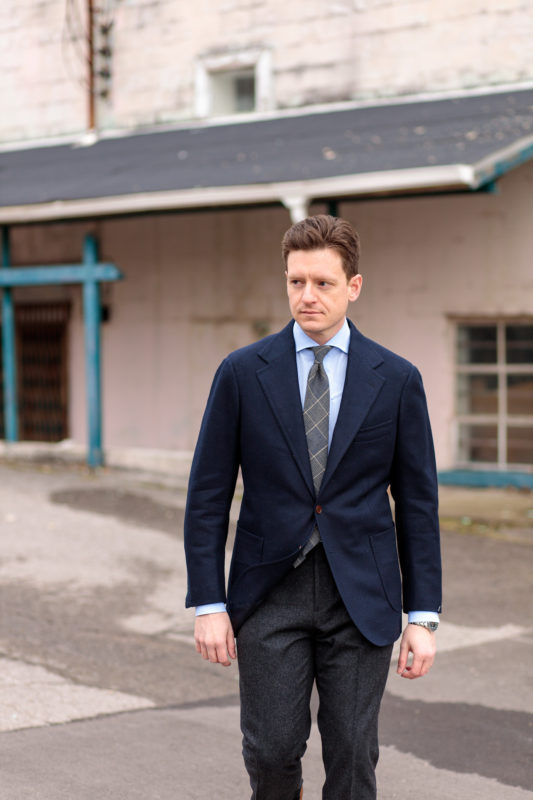
Greg and the team’s fabric selection for their off-the-rack collections is always very good. One downside of the essentially online-only shopping experience they have is not being able to see and feel a garment in real life—though their photography is second to none in conveying as much as possible through photographs—and my experience with this jacket is a case in point. The heavy wool twill did not appeal to me at all; I chose it because I knew it would photograph well and the design details could be more easily made out. Yet after wearing it for the shoot, it really grew on me as a great, seasonal navy fabric. The take-away here is that if they’re stocking it, you can count on it being really good.
As for fit, it fit me very well. Sometimes, particularly when wearing a tie, I’d get some collar gap. But it wasn’t always there; it’s like it came about only after the jacket had shifted on my shoulders due to some movement. Usually it sat against my neck. This is a situation where I wish I could have a master tailor look at it and explain what’s happening. But it wasn’t egregious or even frequent enough to make me think it’s a serious issue that couldn’t possibly be rectified by some alterations.
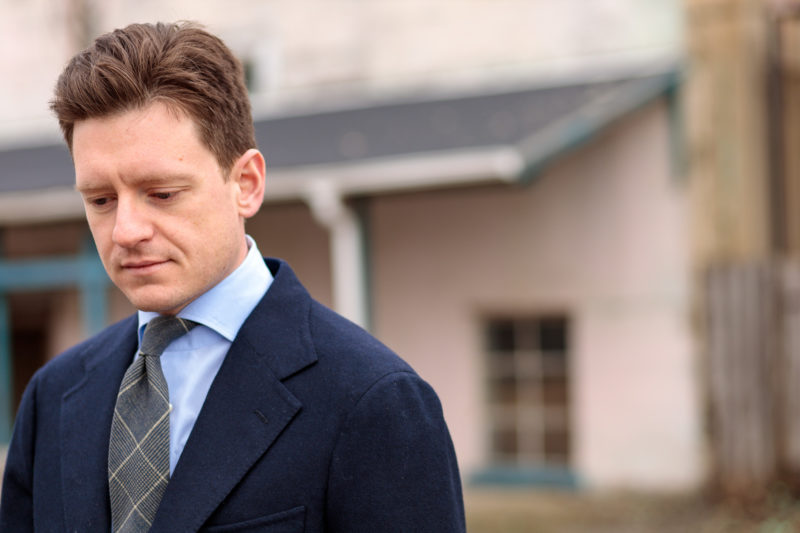
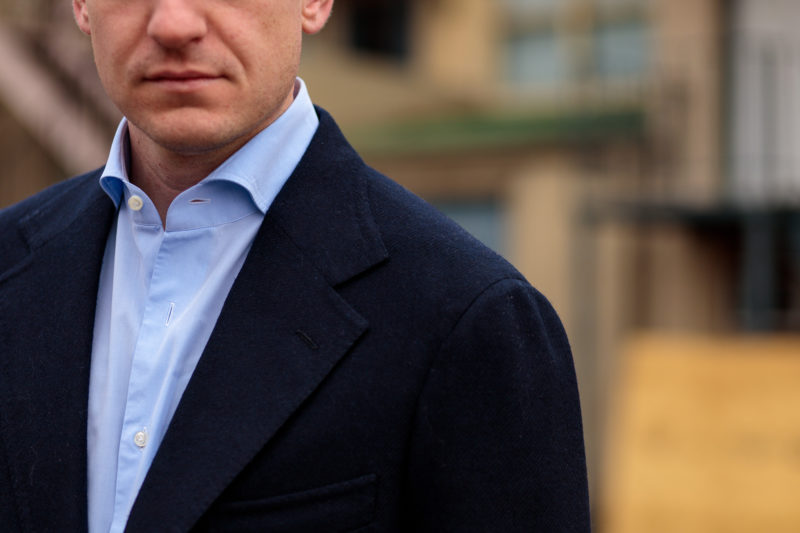
I asked Greg some questions about this line to give some context and to explain a bit about the thinking behind it (as I have all the other makers in this ongoing series about tailoring brands I love). He generously took the time to give me some very thoughtful responses, which you can read below.
Many thanks to Greg for agreeing to send me this jacket on loan to try on, photograph and write about!
Mitchell Moss: What is the raison d’etre for this line of clothing?
Greg Lellouche: Our tailoring offering has always been very collaborative, whether it was designing a ready-to-wear line from scratch with Sartoria Formosa and picking all the fabrics and details, or working with Antonio Ciongoli to create an Eidos model specifically for NoMan, picking fabrics to assemble a coherent “collection” every season. We liked the idea of having a more accessibly priced tailoring offering like what we had with Eidos, working with a workshop focused on creating quality full-canvas garments in the tradition of Italian luxury manufacturing. But by using sewing machines more than hand-sewing and getting economies of scale on the best quality fabrics in greater lengths, we are able to pass on additional savings to our customers.
After Antonio left Eidos, we were focused on replacing that offering with one that would also allow us to offer made-to-measure, as it is clearly something that our customers have been asking for. In fact, having a core MTM capability and all the processes and quality controls that go with that was a primary decision factor. We spent over a year reviewing options and having prototypes made, but were won over by Sartoria Carrara’s deep expertise. Not everyone is aware of just how much of a nexus for high-end tailoring Carrara/Massa is. That’s where some of the best Italian ready to wear was produced when D’Avenza was there. When D’Avenza was bought by Cucinelli, a lot of the ultra-skilled tailors and workers found homes with places like Sartoria Carrara and the new Liverano workshop there.
We leveraged Carrara’s incredible pattern-making expertise and thousands of data points from their various MTM programs to create our own style. It fits a wide range of body types really well, and the MTM program is flawless—they have great precision of make and quality control. We’ve been really impressed.
MM: How would you describe the style of the Carrara collaboration line?
GL: It’s a very classic silhouette, something that is comfortable and (I hate to say it) quite timeless. It’s neither “fedora” retro, nor overly contemporary. We really wanted to step back and understand what works and what has been happening to silhouettes in tailoring over the last decade or so. The advent of a “neo-Neapolitan” cut, created mostly for export markets, is something that could not be missed over that time. Gorges getting higher and higher, jackets getting shorter and shorter, buttoning point way above the navel, trousers getting slimmer and slimmer… We found great dissonance between what was marketed as an “Italian” or “Neapolitan” cut and what we could see on Italian guys when traveling there multiple times a year. So we stepped back and wanted to revert to proportions that make sense for the wearer, that are comfortable and flattering. The best way to do that was to reset the style to what Sartoria Carrara’s house cut was as a Tuscan tailor, removing the layers of design changes that their other clients had added. From that point on, we made very few changes (we lowered the buttoning point a little and lengthened the coat a little) and stayed true to their core DNA.
MM: Who do you think of as your customer and how do you meet his needs and wants?
GL: Any guy who cares about what he wears, how it is made, who makes it. Someone who wants to invest in great quality, original design and support sustainable business practices.
MM: What level of quality are these clothes made to, and what sets it apart?
GL: They’re full canvas tailoring, which is imperative to have a jacket’s shape evolve and feel/fit better over time. We only use the very best fabrics, trims and internal construction elements (even if they cannot be seen)—the canvas is softer than most RTW, but not too unstructured either. The shoulder is natural and has no pad, just the chest piece coming up and over the shoulder to smooth the line and give it a little structure. Fabrics are cut by hand on our patterns, then some steps in the assembly are done by hand because that’s where it makes the most sense and a real difference in how the jacket fits (those tend to be the rounder seams such as the armhole, collar, gorge and some of the lining attachments). We also wanted a hand-sewn lapel buttonhole, because it’s pretty and worth the extra money, in our opinion. Trousers have all the makings of a high-end trousers (trust us, we’ve seen a lot) with a curtained waistband, strong tacked pockets, etc…
I think it’s difficult to assess quality in a tailored garment, mostly because sometimes a great fabric can give off the impression that the make is great, but that’s not always the case. I feel that one can tell when wearing a well made jacket that is is a quality garment: the way it sits cleanly on the shoulder, the way it rests on the neck, hangs from there, etc.
MM: Are there any other special things about the line that you want to say?
GL: There are many other options out there for customers and we believe that there are still men who want the real thing. There’s even a whole market that has developed now in tmenswear for pseudo-Italian clothes: Italian cuts that are reverse-engineered and made in low cost countries at unbeatably low prices. This new phenomenon means that one no longer has to pay the price of Italian savoir-faire, workers’ wages, the implied royalty that comes with the styling they created, etc. The look can be replicated, like it’s been seen for a couple decades successfully in fast fashion. Needless to say that not a week goes by when we’re not contacted by factories who want to make low-cost garments for us. We’ve never really been into the idea of selling that kind of clothes or selling for the lowest price. We feel that our mission is to bring lovely, well-crafted products to our customers, and at the same time ensuring that those crafts survive and thrive.
What those men and women make at Sartoria Carrara and the knowledge they carry forward for the next generations is something we find is worth supporting. But we don’t fool ourselves into thinking that this is why customers will choose the No Man Walks Alone tailoring program over others. I think that the fit, comfort, quality of make, and the accuracy and convenience of the MTM program are what round up the value here.
Shop the Look
No Man Walks Alone by Sartoria Carrara jacket in Abraham Moon heavy wool twill
Blue spread collar shirt: Similar from Anglo-Italian, Kamakura, Suitsupply
Tie: Similar from Vecchio Anseatico, Anglo-Italian
White jeans: Sid Mashburn natural denim | J. Crew 770 slim straight white jeans
Charcoal flannel trousers: Rota charcoal flannel trousers
Boots: Meermin snuff suede chukkas (I wish I’d have worn dark brown suede, just saying).
(Help support this site! If you buy stuff through my links, your clicks and purchases earn me a commission from many of the retailers I feature, and it helps me sustain this site—as well as my menswear habit ;-) Thanks!)
